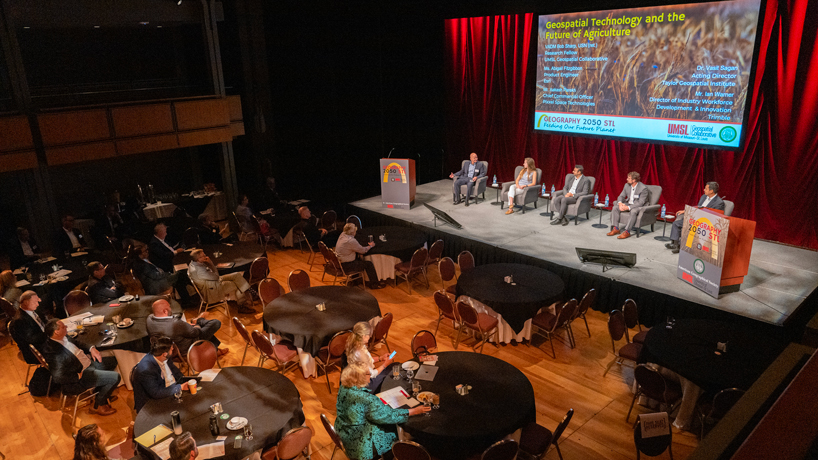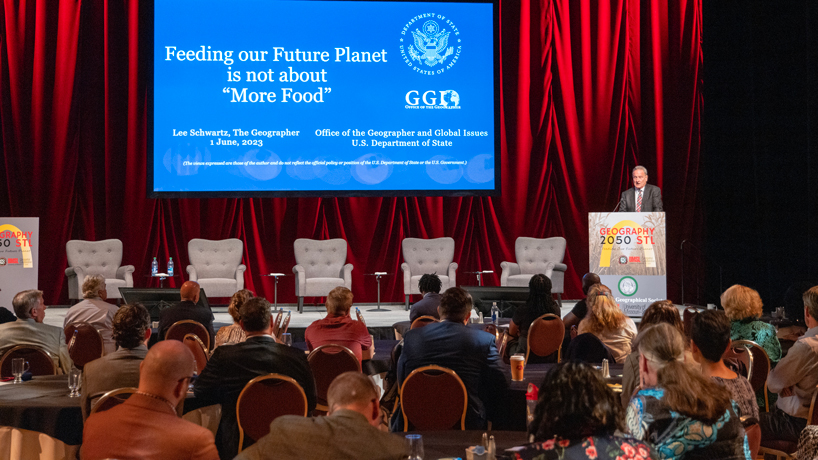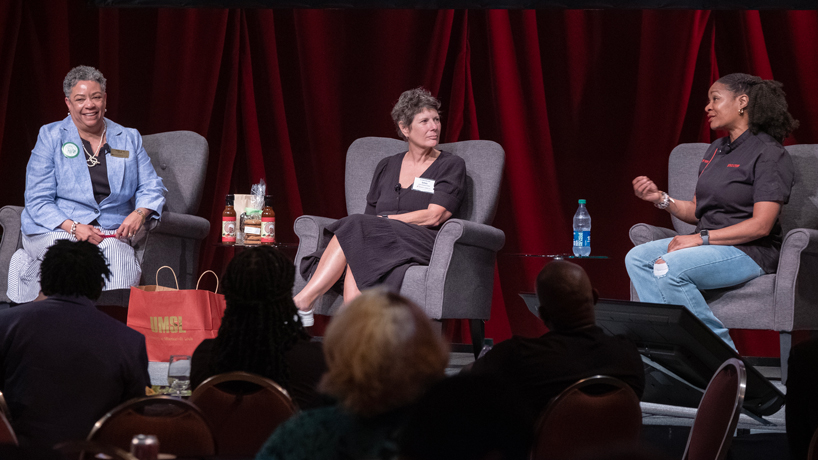
Retired Vice Admiral and former NGA Director Robert Sharp (seated on stage at left), now a research fellow with UMSL Geospatial Collaborative, moderates a panel on “Geospatial Technology and the Future of Agriculture” during the Geography 2050 STL symposium inside the E. Desmond and Mary Ann Lee Theater at UMSL’s Blanche M. Touhill Performing Arts Center. The symposium brought together industry executives from both geospatial technology and agriculture with geoscientists, researchers and entrepreneurs for discussions on the topic “Feeding Our Future Planet.” (Photos by Derik Holtmann)
American Geographical Society President Marie Price had one wish for attendees of Thursday’s Geography 2050 STL symposium as she joined AGS Chairman Christopher Tucker in welcoming them to the campus of the University of Missouri–St. Louis.
“I’m hoping by the end of this day, somebody’s going to get up and speak and it will blow your mind,” Price said as she looked out over the audience from on stage in the E. Desmond and Mary Ann Lee Theater at the Blanche M. Touhill Performing Arts Center.
American Geographical Society President Marie Price (at left) and Chairman Christopher Tucker welcome attendees to Geography 2050 STL: Feeding Our Future Planet on Thursday in the E. Desmond and Mary Ann Lee Theater at the Blanche M. Touhill Performing Arts Center.
More than 120 people attended the daylong event, which brought together industry executives from both geospatial technology and agriculture with geoscientists, researchers and entrepreneurs for discussions on the topic “Feeding Our Future Planet.” They explored food systems and food production and its connection to global challenges such as poverty, health and sustainability.
The morning’s first panel on “Geospatial Technology and the Future of Agriculture” helped set the stakes. With retired Vice Admiral Robert Sharp, the former director of the National Geospatial-Intelligence Agency and now a research fellow with UMSL’s Geospatial Collaborative, serving as the moderator, Esri product engineer Abigail Fitzgibbon discussed how climate change will impact U.S. and global agriculture over the next quarter century and beyond.
“When we talk about the impacts of climate change, we’re really thinking a lot about warming, and particularly the impact of warming across the United States,” she said. “We all know that climate change will touch every corner of the globe, but when it comes to warming particularly, there are some areas that will be disproportionately impacted, and one of those areas is right here in the central and particularly northern United States. Warming in this part of the region could warm 7 degrees Fahrenheit with our worst climate predictions by middle of century.
“When we talk about climate change on these very agriculturally productive parts of the world, we’re really thinking about the cascading geopolitical and social impacts that can come from that. Agriculture is a very complex system involving a lot of soil science, labor markets, water, etc. And a lot of geopolitics as well.”
Fitzgibbon and her fellow panelists, including Vasit Sagan, the acting director of the Taylor Geospatial Institute, discussed the importance of using geospatial technology to both study and adapt to the changing climate.
“We face some grand challenges,” Sagan said. “The reality is we have to feed the growing population. To do that we have to produce 70% more food by 2050, and we have to do this with limited and often actually shrinking water resources and arable land. In my view, the technology is the best tool to get us there. With those imaging technologies and AI and machine learning, we can improve yield, and then we can maximize the profit for our farmers as well with data analytics and those up-and-coming imaging sensing computing technologies. Only then we can empower our farmers improve the quality of life for everyone globally.”
Later panels featured others deploying new technology in innovative ways to address food challenges and improve productivity.
Geographer of the United States Lee Schwartz delivers a presentation at the Geography 2050 STL symposium. Schwartz discussed how feeding the future is not only an issue of food.
Attendees also heard from Lee Schwartz, the Geographer of the United States, whose office is housed in the U.S. Department of State. He discussed issues of equity in a presentation titled “Feeding the Future is Not About Food.”
The daylong event was an extension of the Geography 2050 series that AGS began nine years ago in collaboration with Columbia University. The series explores vital trends that will reshape the geography of the planet over the coming decades.
UMSL Chancellor Kristin Sobolik attended last fall’s Geography 2050 symposium in New York and was instrumental in working with Tucker and others to expand the series to St. Louis and explore a subject directly affecting the nation’s heartland.
St. Louis was the ideal location for the symposium because it is at the intersection of agriculture and geospatial technology, with its location in the heart of the Midwest and its growing status as a national hub for geospatial technology, research and analytics.
AGS officials were excited to partner with UMSL as the only public research university in the region and with its shared interest in growing knowledge, learning and exploration of geographic science and technology to prepare the geospatial workforce of the future. The university has been making investments in geospatial labs and new academic programming and has signed both a Collaborative Research and Development Agreement and an Educational Partnership Agreement with the National Geospatial-Intelligence Agency.
“We made the decision as an AGS board to co-host our 2050 conference with the University of Missouri–St. Louis and bring in leaders from across the world to discuss, share and grow this incredible area of strength,” Tucker said. “But we know that this relationship is moving beyond just that. It’s not hosting a conference. It’s bringing people to the city that will be the global hub, and UMSL is staking its claim as the workforce provider in that area. We’re all in. We support them, they support us, and so we are proud to enter into this partnership, and we will announce more to come as this partnership grows.”
Thursday’s symposium had a local flavor with St. Louis-based entrepreneurs taking part in several panel discussions. Professor Haitao Li, the chair of UMSL’s Department of Supply Chain and Analytics, moderated a panel on “Indoor Agriculture and the Future of Self-Feeding Cities,” and panelists Tony White, the CEO of Tony’s Family Farms, and Tyrean “Heru” Lewis, the CEO of Heru Urban Farming, who grow produce around the region and often partner with local restauranteurs.
UMSL Chief of Staff Adella Jones and SqWires ownerr Bethany Budde-Cohen listen to Cathy’s Kitchen owner Cathy Jenkins during a discussion with the two local restauranteurs during the Geography 2050 STL symposium.
Lewis participated in UMSL’s first Anchor Accelerator and received business training and $50,000 in nondilutive capital as he works to bring healthy food to parts of the region that have been food deserts.
UMSL Chief of Staff Adella Jones led a discussion with local restauranteurs Bethany Budde-Cohen of SqWires Restaurant and Market and Cathy Jenkins of Cathy’s Kitchen about their experiences as delivering food to their customers.
There was also a session focused on building the next generation of mappers through YouthMappers, an international network of university-student-led chapters that organizes, collaborates and implements mapping activities designed to respond to development needs around the globe.
Connected to Thursday’s symposium was a workshop that brought teachers from Missouri and surrounding states to learn about geographical and geospatial resources available in St. Louis, applications of geospatial tools and technology in their classroom, geospatial careers that could be available to their students in the future.
UMSL is committed to developing the K-16 talent pipeline in its role as a main driver of geospatial workforce development in the St. Louis region.
“Most people don’t know anything about geospatial,” said Reda Amer, the director of UMSL’s Geospatial Collaborative. “When you say geospatial, the first thing that might come to mind is spying and satellites. They don’t think it’s something related to them, but they use it every minute, every day for everything. Even when they’re watching TV, all the information that comes to them is from geospatial. So, we want to educate people and give them information to help them to start thinking geospatially and know how this is important for everyone and for the future our nation.”

















